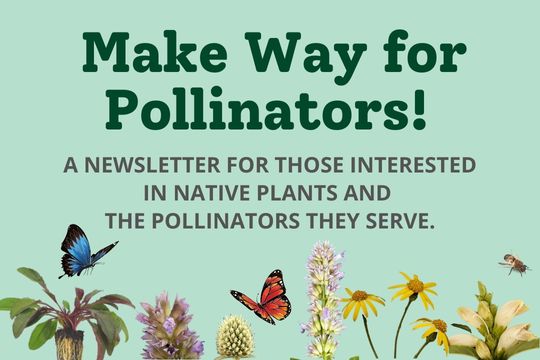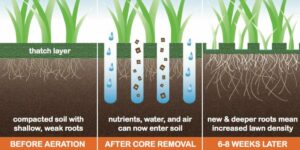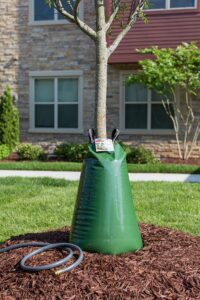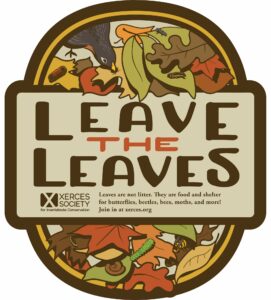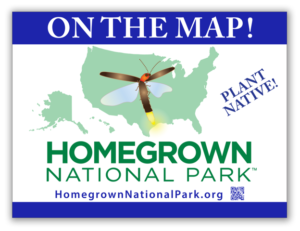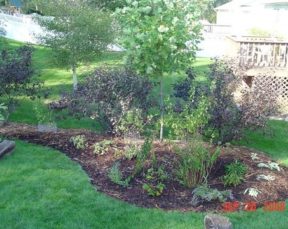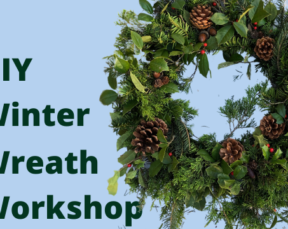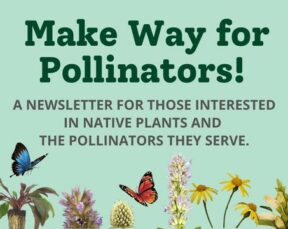Caring for a pollinator garden during a drought
Late summer and early fall can be a tough time for a newly establishing pollinator garden. The hot, dry days can leave newly planted flowers with establishing root systems parched, leading to wilting under the hot summer sun. These are the days that are most critical to water your garden; however, it can be difficult while conserving our dwindling New Jersey water supplies—and this applies whether you are on well or municipal water supplies. Here are some tips for keeping a healthy garden while limiting and making most efficient use of water supplies.
An important first step when creating a water-conscious garden is to use organic composition mulch. And lots of it! Bare soil dries out much faster than if it is covered with mulch and organic matter (such as grass clippings/leaves or shredded bark). The mulch provides a barrier and minimizes evaporation of water to dry air keeping moisture in the soil where is can do the most good. The organic matter also holds more water, acting like a sponge and keeping things moist for longer in the plant root zone. Drip lines or weep hose can be installed below the mulch layer so that all applied water can travel directly into soils, minimizing evaporation. Purchase weep hose at hardware stores, or create your own with a drill with a ¼” bit and an old hose.
Next, become more time conscious!!! What time of day you water your garden or lawn can make a huge difference in the amount of water plants will receive. Always avoid watering your garden in the heat of the day, since evaporation rates are highest then. Watering in early mornings before 6am or late evenings after 8 pm will cut down on the amount of evaporation as well as prevent plant leaves from becoming scorched. You can purchase cheap hose times that will mean you don’t need to be up at the crack of dawn to water—just remember to buy one with a water sensor or rain override—so you aren’t the one watering in the downpour! If you must water in the hottest part of the day, direct spray into soil rather than onto leaves to avoid scorch—water droplets act like magnifiers in the heat burning leaves.
When watering your garden, it is important to give your plants infrequent and heavy soakings, rather that little and often. Native plant nurseries know how to create hardy plants, rather than water hungry weaklings. They water only when plants begin to wilt, creating plants adapted to less water. Watering fully less frequently encourages roots to grow deeper and broader as they seek out water and will create more resilient plants, especially in the dryer months. Watering little and often creates mat-like superficial roots not well adapted to drought.
Be a water miser! While watering lawns (if you must and are allowed) or meadow, measure how much water you use. Lawns and meadows only need an inch to an inch and a half for the week, so consider watering a half inch three times a week. Place a coffee can in the way of the sprinkler to see how much water you are applying and how much time your set up takes to deliver the required depth. If you use a sprinkler, set the sprinkler angle low so it is directed more at the ground rather than the air to minimize evaporation.
If you must water lawns, consider only watering core areas used regularly, rather than empty front lawns—in a drought good neighbors know beige is the new green! Quite often, heavily trafficked areas on your lawn can cause the soil to become compacted, especially if you walk on soils while they are wet. This limits the amount of water they can absorb. Using a spike, or better yet, a core aerator to uncompact lawn pathways and heavily trafficked areas will allow water to penetrate deeper into the soil and roots reducing runoff and improve lawn health.
For trees that are establishing, are in drier soils, full sun or require more water, consider purchasing a tree watering bag. Once filled, the tree watering bag will release water directly down into the tree roots over the course of a few hours, giving thirsty tree roots time to absorb the water efficiently with no evaporative loss.
For flowers, dead head plants soon after flowering. After flowering, plants shift their energy resources into seed production. In ideal conditions this is no issue since there is minimal stress and plenty of energy available to produce seeds or fruits. During droughts, however, plants are already stressed and do not have the excess energy to spend producing seeds, better to keep the plant alive allowing it to make seed next year.
Lastly, be a rainwater hog! Collect all the rainwater you can! Rain barrels are a great way to minimize downstream flooding while also lowering your municipal or well water use. If you already have a rain barrel, make sure to empty it if there is rain in the forecast so it can collect the greatest gallonage possible. If there is water still in your rain barrel before the next rain, consider connecting it to a drip hose. Instead of diverting downspouts onto impermeable surfaces to rapidly conduct water away, consider attaching long extenders to take water into foundation beds and plantings away from the house. Reusing household grey water can also make a big impact if you don’t mind some work. Stick the plug in the shower, and bucket water to where you most need it! Ensure any soaps or cleansers you use are biodegradable, and avoid pouring greywater on leaves, as soap can allow water loss through the plant surface epidermis, and to prevent burning the plant leaves.
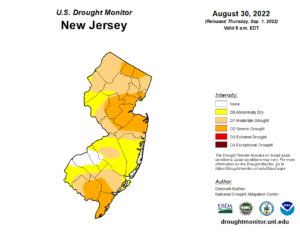

Click on photo to view larger. New Jersey | U.S. Drought Monitor
The droughts that have occurred in New Jersey and beyond over the last few years are not expected to go away any time soon—in fact they are expected to get worse and more frequent as climate change causes the hots to get hotter, the wets to get wetter and the dries to … well, you get the idea! Because of this, it is best to adjust your garden accordingly, choosing landscape solutions that do not require excess water. Xeriscaping, the practice of gardening with minimal water use is catching on. If there are plants in your garden that need lots of water, or need to be babied in hot summers, switch them out for more drought-tolerant species for less watering in the future. (hint: lawns are super thirsty!) Native plants, for example, are often tend more resilient and adapted to dry conditions, so look to natives rather than ornamentals!
Plant it Forward is Back!
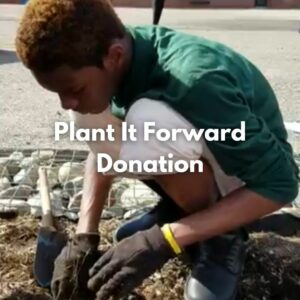

Help GSWA staff to spread the joy of native plants to schools throughout the Passaic watershed. Click to Donate!
Thanks to everyone who donated to the Plant it Forward campaign during our 2022 GSWA Plant Sale. For any who missed it, buying plants and soil amendments through Plant it Forward will support supplies to be donated towards installing raingardens in downstream communities such as Paterson. For a brief time, the Plant it Forward opportunity will be for anyone who would like to donate plugs, soil amendments, or even a few trees and shrubs to schools GSWA works with.
With the increase in impervious surfaces such as houses, parking lots and roads, a typical rainfall event within the Passaic River Watershed can lead to significant flooding in downstream towns like Paterson and Newark. One way to begin to mitigate these flooding events is to create green infrastructure—vegetated areas that can absorb and store stormflow. Green infrastructure includes permeable surfaces such as vegetated retention basins called raingardens. Over the years, throughout the Passaic River Watershed, with a focus on urban centers with little green spaces GSWA and partners such as Rutgers GSWA has installed and maintains multiple rain gardens in schools throughout Paterson. We want to create more! A raingarden does not only reduce flooding, but serves as a great learning tool for students. Rather than simply installing the raingardens with our partners, GSWA involves the students and uses this opportunity to teach environmental science topics. Students learn everything from why their schools and homes flood so often to the importance of habitats and ecosystems, they even choose the plants that best attract and serve wildlife including pollinators. Once the raingarden is installed, the students can then conduct scientific experiments within the raingarden and help with ongoing maintenance.
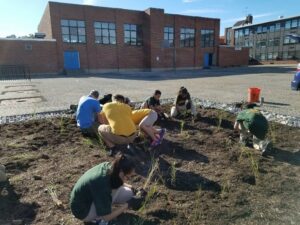

Paterson PS 28 Rain Garden. Read more about the Paterson Public School Raingarden.
During a raingarden project, students are tasked to choose the best plants for their raingarden—just as all our Plants for Pollinators purchasers did when browsing the website during the plant sale!
Students look at bloom color, timing, wetness preferences and even what wildlife each plant supports to create a raingarden that supports the greatest biodiversity possible. Once the plants are picked, it is time to dig! The students glove up and plant the flowers, shrubs and trees that they decided were the best for their garden.
If you missed helping with Plant it Forward during the Native Plant Sale, there is still time to donate! GSWA will be re-opening the Plant it Forward link to enable you to support purchasing plants, soil amendments, trees and shrubs for future raingarden installations.
From No Mow May to Certified Wildlife Habitat and every sign in between!
Good communication is essential in the art of selling and explaining your yard to others! Yard signs are a perfect way to educate neighbors and passersby on how and why you are helping wildlife in your yard. To the untrained eye, neighbors who take part in ‘Leave the Leaves’ and ‘No Mow May’ might be mistaken for lazy gardeners, being neglectful of their yard. Likewise, native pollinator gardens to the untrained eye might be (incorrectly) viewed as a weedy, unkempt garden since many native plants are not distinguished from weeds by those typical suburban gardeners not in the know! Yard signs can educate neighbors and others that what you are doing with your yard and garden is very much intentional, as well as beneficial to the local ecosystem. There are signs for almost everything you can think of; however, finding where one can buy or print these signs can sometimes be the trickiest part.
Here are a few of the more common signs that you can consider putting up on your yard or garden!
- For quick and easy display, free printable signs can be found on native plant websites. If you are participating in No Mow May next year for example, consider this sign next spring to print out this free PDF courtesy of the Xerces Society: https://xerces.org/publications/other/no-mow-may.
- If your garden has been added to the Homegrown National Park map (and we strongly encourage you to consider adding your dot to the plethora of other NJ gardens enrolled) there is a free printable sign for that as well that can be found here: https://homegrownnationalpark.org/yard-sign
- There are numerous places to buy more durable metal signs as well. If you missed the 6” or 12” pollinator pathway signs that were for sale during our Plant Sale or just want additional signs you can purchase them here: https://www.pollinator-pathway.org/sign.
- The Xerces Society has signs for Pollinator Habitats, available in English and Spanish, and ‘Leave the Leaves’ signs available with a donation. These signs can be found at https://gifts.xerces.org/collections/donations.
- If you are dedicated to helping the Monarch Butterflies as they migrate, consider a Monarch Waystation Sign that can be purchased here: https://shop.monarchwatch.org/product/Monarch-Waystation-Sign/125618. The monarchs can’t read, but it may encourage your neighbor to ask for some of your milkweed seeds next year!
- Lastly, if you are focused on creating and supporting habitat for all wildlife, get your habitat certified through the National Wildlife Federation- it is a relatively straightforward process and get your Certified Wildlife Habitat sign here: https://www.nwf.org/CERTIFY.
If none of these signs speak out to you, make your own! Home-made signs can add an individualized touch to spread the word about the importance of supporting wildlife and biodiversity in your town.
Edits in the Garden—Switching to Native Plants, Maintenance, and more
Those of us who do our own gardening know that any open space doesn’t stay that way for long. Whether it’s tree seedlings, weeds, or even volunteer natives popping up—we’re rarely starting our garden from scratch. If you’ve just started planting native, you may be struggling to decide what to do with your non-native landscaping, and how to keep your native gardens thriving once they’re in place.
The good news is you don’t need to tear out every non-native plant you have! Although native plants are best for pollinators and for local area biodiversity, not all introduced species are invasive. Consult a [do not plant list] when deciding which of your landscaping plants might pose an active threat to local habitats, and work towards removing those from your garden. Healthy habitats also require diversity, so any one species taking up a large area of your garden should be trimmed, thinned, or dug up to make room for a wider variety of plants. (Psst, that includes lawn grass, which provides little in the way of native wildlife value.) If you have over enthusiastic amount of one native species taking up most of your garden, consider removing some plants and sharing them with a neighbor or friend.
Now that you’ve created some space, you can decide what kinds of plants belong in your garden. Keep biodiversity in mind for this step—not only by having a wide variety of species, but multiple types of plants. A combination of trees, shrubs, flowering plants, and groundcovers gives your garden a wider range of habitat than if you have only—say perennials. Different life stages of our native pollinator species requires different plants. If you notice a gap in blooms between May and July, consider adding a plant that flowers in June. Not only will this add beauty to your garden, but it will also provide for any pollinators present during that window.
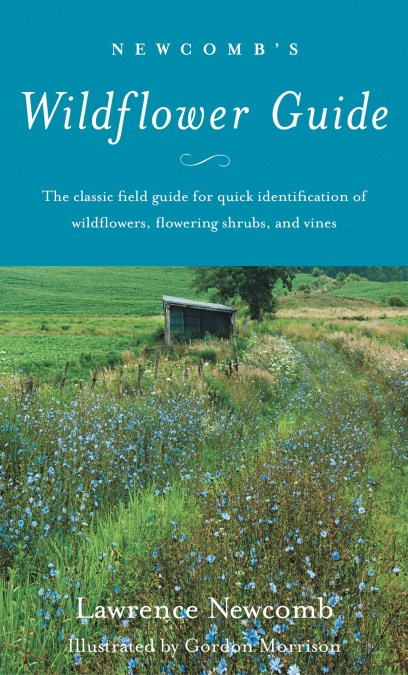

When it comes to pulling weeds, try to be consistent. Once your native species fill in, many will be able to out—compete smaller lawn weeds, but until then keeping lawn grass, invasive vines, and other weeds out of the garden can do a lot to help your native plants grow. If you have trouble identifying weeds—especially tricky early in the year when other good plants are small. Taking pictures of your plants year-to-year, or keeping a list of what you have planted, can help you when it comes to identifying weeds. Pull any weeds you can positively identify early in the spring but wait until later in the season to pull those you might be able to confuse with your native plants.
With these simple guidelines you can edit your existing garden, help provide habitat for native species, and keep it looking beautiful year to year.
Thanks to Morris townships e-news for highlighting this great list of valuable natives you can use to replace detrimental invasive species with. Take a survey of your yard and if you have any of the plants on the left-hand list, consider planning to replace with plants on the right hand list! Native shrubs have the added value of often being larval food plants for pollinators and pupal and over wintering locations for many beneficial bugs. Plan for fall, which is a great time to plant shrubs and trees.
Tip of the Month: Replacing Common Invasive Ornamentals with Similar Natives
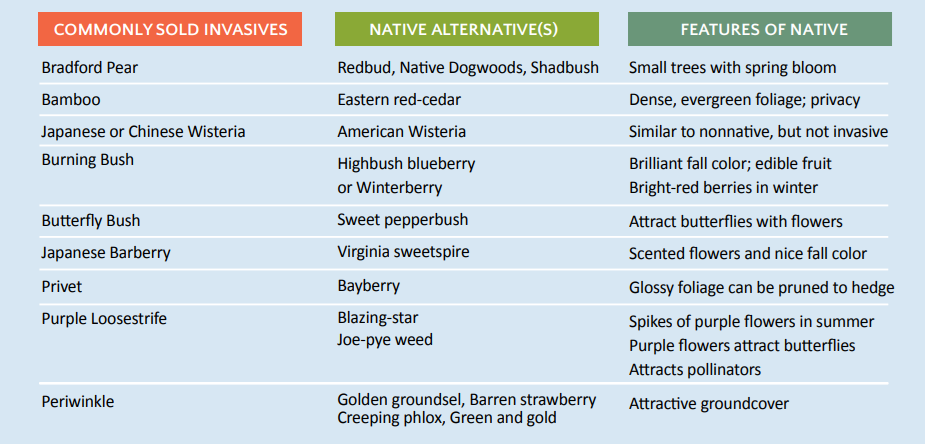
Photo Credit: Native Plants for the Small Yard
What’s Flying in the Garden Now?
If your natives are thriving and doing their thing, you should be seeing a ton of flying insects right now. Our yard is filled with butterflies, moths, bees of all colors, shapes and sizes and many other hover flies and beasties that seem to love the many plants in bloom. If you are not a trained entomologist, you might be wondering what’s flying right now, but feel unsure of how to identify the species you see.
There are several online and good book resources that can help beginners become expert pollinator spotters.
Pollinators of Native plants—Attract, observe and identify Pollinators and Beneficial Insects with Native Plants, by Heather Holm (Pollination Press) is a great guide, filled with glossy pictures and cross-linked lists. You can start with the flower you have and see what insects visit upon it or find your flier and see which plants it visits. There is good, but not overwhelming natural history information presented on these species too.
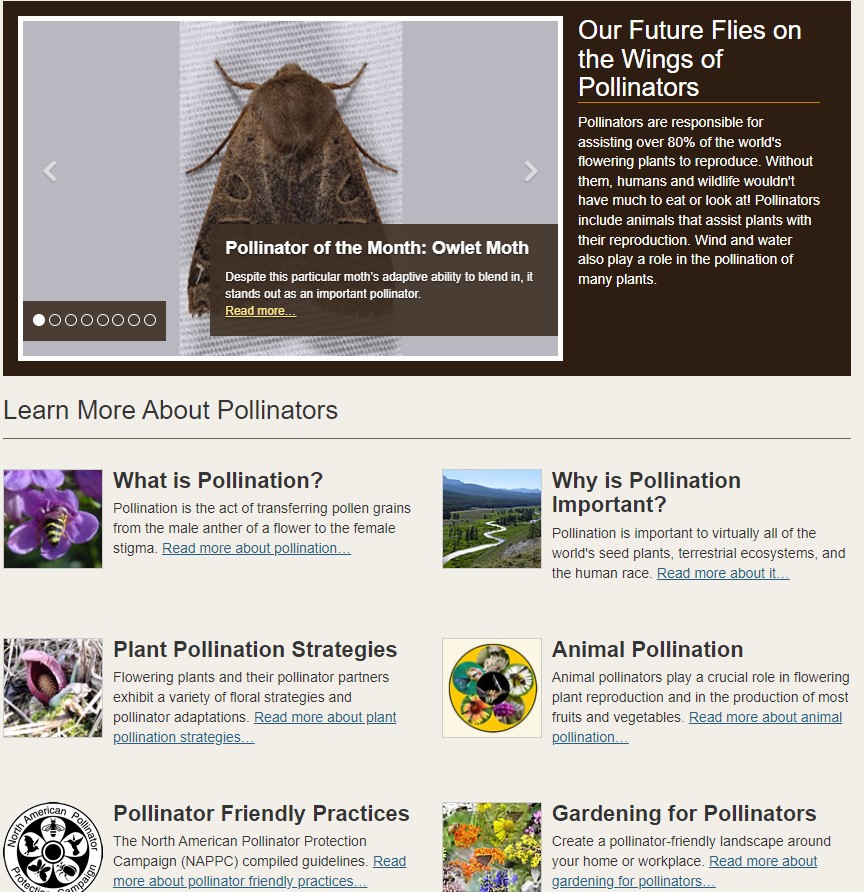

Xerces Society, as you might expect, has huge amounts of information on all thing’s invertebrate, including the downloadable PDF Bumble Bees of the Eastern United States and lots of other useful identification information.
Get your kids involved with observing pollinators up close…there are even guides to identify species for kids. You will never regret the hour you spend watching myriad bees visit flowering bergamot or coneflower or waiting patiently for the hummingbird to sip nectar from the cardinal flower. With a little patience and time in the garden you will begin to know the secret ways of the many pollinators that are calling your garden home.
